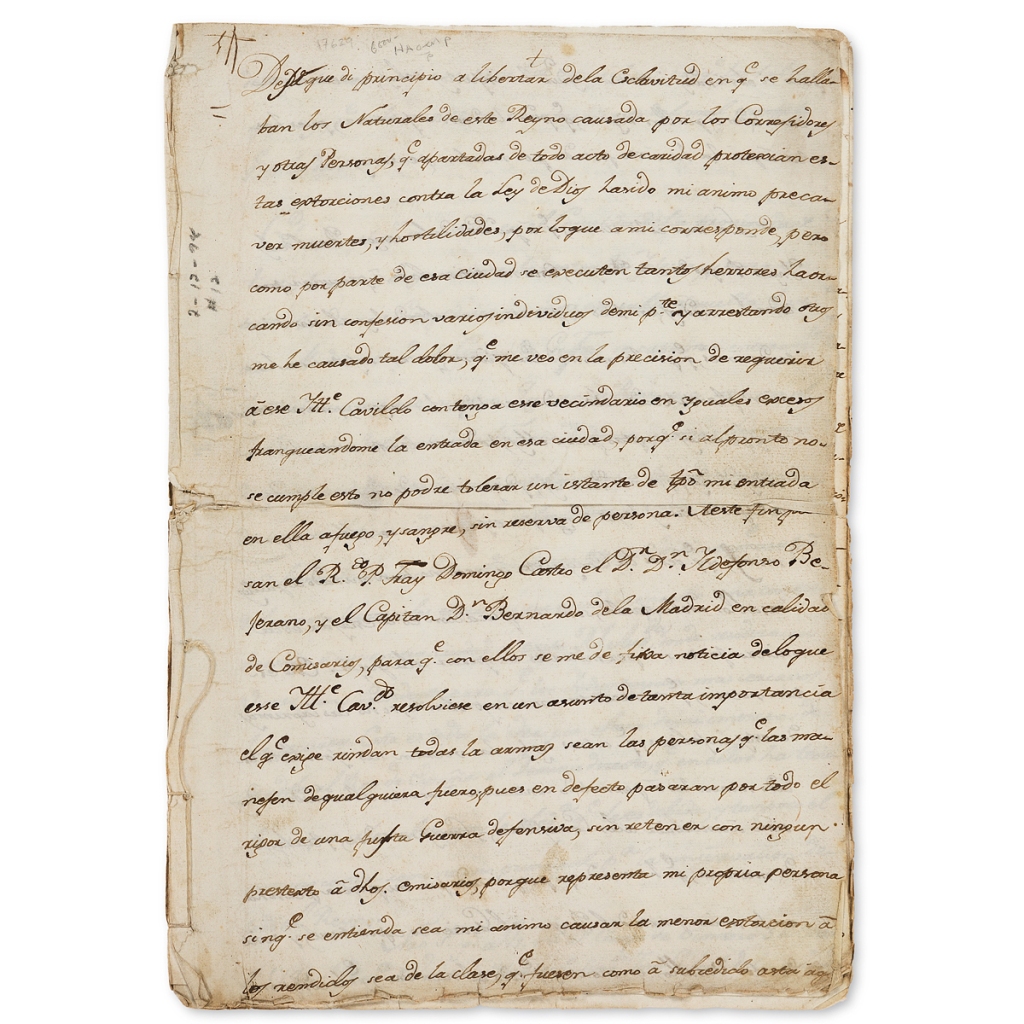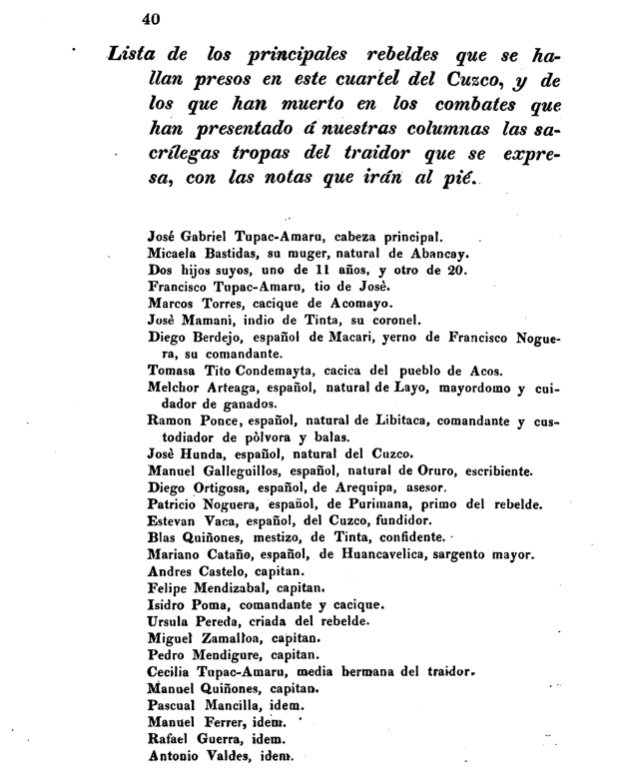by Avery V., June 2024

The document above is one page of the letter written by cacique Túpac Amaru II to the citizens of Cuzco, Peru. Written in on January 8th, 1781, Túpac explains which laws the Spanish had violated and how it was hurting the indigenous people of the country. Túpac writes, “Los Naturales de este Reyno, causada por los Corregidores y otras personas, apartadas de todo acto de caridad, [sigue] estas [acciones] contra la Ley de Dios” (Túpac Amaru). In english, Túpac says, “The Naturals of this reign, caused by the Corregidors and other people, apart from all acts of charity, follow these actions that are against the Law of God.” In writing this letter to the people of Cuzco, people who range from all classes and walks of life, he is including “ordinary” people into his fight. He gains their trust and support while actively recognizing their struggles and pulls them into the larger conflict between the Spanish and indigenous peoples. Additionally, the letter, among other forms of activism, like speeches, messages, and ideas spread through word of mouth, was fundamental to creating the strong army that accompanied Túpac in battle. In addition to the letter being a form of recruitment, Túpac was also educating the people who were not capable of understanding the reality of the situation and reassuring them that what was happening was both immoral and discriminatory.
The city of Cuzco was hit particularly hard when the Spanish employed the Bourbon Reforms, a series of laws and regulations created to benefit the Spanish both economically and defensively. According to Campbell, “Many of the Bourbon fiscal reforms, particularly the collection of Indian tribute and sales taxes, which were raised from 4 to 6 percent, had been enforced more stringently in Cuzco by the irascible Areche after 1777” (Campbell 680). This meant that the people of Cuzco were disproportionately affected by the increased tribute established by the Spanish and had to suffer in silence. However, José Gabriel Túpac Amaru II, a direct descendent of Túpac Amaru, the last Sapa Inca of the independent Inca Empire, did not stand for the injustice and decided to fight for his people. Túpac Amaru II had a lot of credibility and power during the late 18th century. In following the footsteps of his revolutionary father, Amaru II imprisoned Antonio de Arriaga, the Spanish corregidor of Tinta (Campbell 679). Naturally, this frightened the Spanish elite as the unpredictability of the indigenous people became abundant. With this newfound power, Túpac created an army strategically composed of high-status Creole (American-born Spaniards) and mestizo (persons of mixed race, specifically one of both indigenous and Spanish descent) military men (Campbell 684). Without the support from Cuzco, however, Túpac would not have been able to create such a strong army to withstand the Spanish.

Above is a list of 29 members from Túpac’s army who were either imprisoned or murdered in battle. According to the document, each member had a specific role crucial to success of the rebellion. There are a couple of members however, that are specified by their relationship to Túpac, rather than their offices in the army (Relación Histórica de Los Sucesos de La Rebelión de José Gabriel Tupac-Amaru, En Las Provincias Del Perú, El Año de 1780). Much of Túpac’s army was composed of family members, as this ensured both loyalty and trust between the members (Campbell 691). Evidently, the document above reveals the diversity within his army and their roles. However, the indigenous population was not the only victim of the Spanish rule, but the Black community living among them. In the late 18th century, there was a notable, but often times overlooked, movement in Peru titled The Revolt of the Free Negros of Lambayaque (Campbell 141). All people of color, whether native to the land or not, had been violated and stripped of their human and financial rights, which had only led to an uprising of rebellions against the oppressor. Although Túpac’s army specifically did not have a large Black population, every revolt against the colonizers, led by people seeking liberation, was essential to the fight.
The fight for underrepresented indigenous communities still persists today throughout the Americas. Many native voices remain unheard and unfortunately, due to the time in which they happened, and through controlled narratives and erased history, there are not many records of the unexplored activist achievements in Colonial Latin America. Nevertheless, by spreading lesser-known histories such as this one, more people will be educated on specific examples of nationalism and the fight against colonialism.
Works Cited
Campbell, Leon G. “Black Power in Colonial Peru: The 1779 Tax Rebellion of Lambayeque.” Phylon (1960-), vol. 33, no. 2, 1972, pp. 140–52. JSTOR, https://doi.org/10.2307/273342. Accessed 21 May 2024.
Campbell, Leon G. “Social Structure of the Túpac Amaru Army in Cuzco, 1780-81.” The Hispanic American Historical Review, vol. 61, no. 4, 1981, pp. 675–93. JSTOR, https://doi.org/10.2307/2514609. Accessed 14 May 2024.
Relación Histórica de Los Sucesos de La Rebelión de José Gabriel Tupac-Amaru, En Las Provincias Del Perú, El Año de 1780 . 1836, pp. 40–41, http://www.cervantesvirtual.com/obra/relacion-historica-de-los-sucesos-de-la-rebelion-de-jose-gabriel-tupacamaru-en-las-provincias-del-peru-el-ano-de-1780–0/. Accessed 5 June 2024.
Túpac Amaru, José Gabriel . “Letter Written by Túpac Amaru to the People of Cuzco.” Received by People of Cuzco , 3 Jan. 1781.

I like how you explained Tupac’s influence on the indigenous commnity. The letter was definitely a great addition since it displays the bad effect the Spanish had on the indigenous community. I also really liked how you included the Black population that was also affected by the Spanish. I didn’t know Black people were involved with South American colonization. ~Saja M.
LikeLike
I liked how you incorporated different aspects of the Peruvian independence, and emphasized the roles of everyone involved in the army. You also connected it to current struggles of Indigenous people which I thought was really interesting and ultimately brought the whole thing together. Gj! -Malcolm M.
LikeLike
I liked how you chose a movement that not many people know of and you put it together really nicely. I learned about Túpac and his significance to Peruvian independence from Spanish rule. The evidence you provided was helpful and the story of their rise to liberation is inspiring. I love that you spread awareness in your conclusion!!
LikeLike